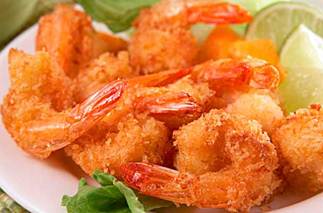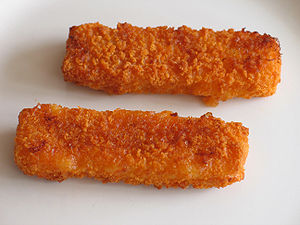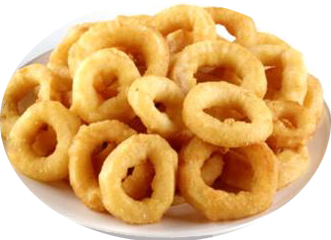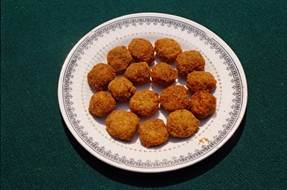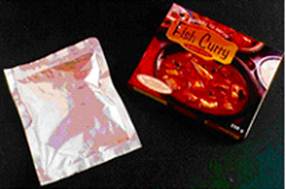
|
||||||||||||||||
| Fisheries :: Harvest and Post Harvest | ||||||||||||||||
VALUE ADDITION OF FISHES MINCE AND MINCE-BASED PRODUCTS Fish mince or minced fish is the flesh separated from the fish in a comminuted form free from scales, skin and bones. Trimmings from the fish filleting operations, whether hand or machine filleting, was the original source of fish mince. Significant value addition will accrue to such fish if converted into fish mince because mince can be used to process a variety of value added products having high commercial potential. Another advantage of the process is that it conceals identity of the original fish from which it is made and consumers may not hesitate to accept mince or mince based products even though the original fish would have been unacceptable as whole fish. Mince can be prepared either from gutted fish or whole fish. Mince from gutted fish will be better in colour, appearance and flavour. For best quality minces it is desirable to use only a single species of fish so that mince of different quality and stability do not mix together. The freshness of the raw material profoundly influences the quality of the mince. The mince will contain all the components like the enzymes, lipids, haem pigments etc. in the fish that affect its shelf stability. The mince is frozen and stored. The fish mince finds application in processing several convenience foods like fish finger, cutlet, burger and also in some low cost salted and dried products. In preparation of fish finger, stick, sake etc., the mince stripped from the bone frame is incorporated to increase the yield. Surimi is a Japanese term for mechanically deboned fish flesh that has been washed with water and mixed with cryoprotectants for good frozen shelf life. Washing not only removes fat and undesirable matters such as blood, pigments and odoriferous substances but also increases the concentration of myofibrillar protein, the content of which improves the gel strength and elasticity of the product. This property can be made use of in developing a variety of fabricated products like shellfish analogues. Meat is separated using a meat-bone separator. The diameter of perforations in the drum should not be larger than 3-4 mm to prevent the skin and scales from passing through the holes. The minced fish is washed repeatedly with chilled water (5-10°C) until most of the water soluble protein is removed. Usually 5-10 times water is used and three washings employed. In the final washing, 0.01-0.3% sodium chloride is used to ease the removal of water and pressed using a screw press to a moisture level of 78-80%. Using a silent cutter, cryoprotectants like sugar, sorbitol and polyphosphates are mixed into the dewatered fish meat at levels 4, 4 and 0.2% respectively. During the process the temperature is not allowed to exceed 10°C above which the protein functionally could be damaged. The total protein lost during the washing process is approximately 30% of the minced meat and depends on the amount of water used and number of washing cycles employed. Kneaded products Several kneaded products like kamaboko, chikuwa, hampen, fish ham and sausage are processed using surimi incorporating other ingredients. The ingredients used in most of these preparations are identical; however, the classification is principally based on the manufacturing process involved. The ingredients employed other than surimi include salt, monosodium glutamate, sugar, starch, egg white, polyphosphate and water. The method of processing all these products involves grinding together of the various ingredients to a fine paste and some sort of heat treatment at some stage. Fibreized products are the greatest in demand among the surimi based imitation shellfish products. The ingredients used in the formulation of fibreized products includes, besides surimi, salt, starch, egg white, shellfish flavour, flavour enhancers and water. All the ingredients are thoroughly mixed and is ground to a paste. The paste is extruded in sheet on the conveyor belt and is heat treated using gas and steam for partial setting. A strip cutter subdivides the cooled sheet into strings and is passed through a rope corner. The rope is coloured and shaped. The final product is formed by steam cooking the coloured and shaped material. Fish cutlets are prepared using cooked fish mince, which is mixed with cooked potato, fried onion and species etc. It is then formed into the desired shape, each weighing approx. 40 g. The formed cutlets are battered, breaded and flash fried for 20 seconds Fish finger is a very popular product made out of fish mince. The mince is mixed with 1.0 per cent salt, made into rectangular slabs and frozen. The frozen mince is cut into suitable uniform sizes. These pieces are given a coating of batter followed by breading. The battered and breaded fish fingers are flash-fried in oil maintained at 180-200° C for about 20 seconds. After cooling the fingers are frozen and stored. Fish Burger Burger is made using mince from lean white fleshed fish. Cooked mince is mixed with cooled potato and mild spices and formed into flat round pieces. These are battered, breaded and flash-fried as for fish fingers. The mince is mixed with salt. Salting will denature the protein and reduce its water holding capacity and hence will result in release of water. The fish/salt mix is pressed suitably to release more water. The resultant cake is dried. Several other products like cutlet, fish ball, paste etc. can be processed out of fish mince. Canning of fish and fish products Canning is a method of preservation of foods in which spoilage is averted by killing the microorganisms present by application of heat and preservation of subsequent contamination, the product being enclosed in a hermetically sealed container. Fish meal is prepared by solvent extraction process on commercial scale. This can be blended with wheat or maize flour and is used as enriching component in bread, biscuits, cakes, sweets and soups. It forms an ideal protein supplement to human diets. Body shell and digestive tract are removed from prawn body and boiled for 15 minutes in 7 per cent salt solution. Fishes are cleaned and cut into 10 cm length and 1 cm width pieces. These are dipped in egg, maida, salt mixture, and then are added to bread powder to prepare sticks. The fishes are cleaned and pieces are boiled with steam. The boiled fish or prawns are mixed with tomatoes, salt, garlic, maida, pepper and oil to prepare fish salad. This can be used in fresh condition or can be stored. Tuna and mackerels are used commonly to prepare fish cakes. Fishes are cleaned and steam boiled, then separated in layers. Potatoes are boiled with salt, pepper and citric acid. Layered fish are mixed with the above mixture and packed in vacuum to prepare fish cakes. The proteins of the fish have high digestibility, biological and growth promoting value. Hence, it plays an important role in human nutrition. The available amino acids are more evenly balanced than the other proteins of animal origin. Amino acids like lysine and methionine are rich in fish protein. In general, fish protein is somewhat superior to egg albumen, bean protein and casein and perhaps equal to chicken proteins. 15 - 25 per cent of protein is obtained from the fish muscle which forms the chief source. The fish proteins are extracted with dilute caustic soda solution from fish fillets or waste after removing the fat. The extracted material is dried after neutralization. This powder is white in colour without any fishy odour and taste containing 80 - 90 per cent of solubilized protein. This is used as a substitute for white of the egg in baking, confectionary, ice cream and pharmaceutical products. The fins of the large sharks except caudal fin are cut near the root, washed in seawater, mixed with wood ashes and lime and dried in the sun or smoked. This product which is crisp and brittle are used in soups and regarded as delicacy. Sushi Shrimp is washed in chilled water containing 5ppm chlorine, beheaded, deveined and again washed in chilled water. Bamboo stick is then pierced between the shell and the meat from head portion to tail and then cooked in 1% brine for two minutes at 100°C. The cooked shrimp is then cooled in chilled water, bamboo stick removed and then peeled completely, including the tail fans. The ventral side is then gently cut down lengthwise completely using a sharp scalpel. The cut surface is then gently opened up to form the butterfly shape, packed in thermoformed trays under vacuum and frozen at -40°C. Shrimp is washed in chilled water containing 5 ppm chlorine, beheaded, deveined, peeled and again washed in chilled water. Bamboo stick is then pierced into the meat from head portion to tail. It is then packed in thermoformed trays under vacuum and frozen at -40°C. Sausages are prepared from the mince of low value fishes along with ingredients like starch, sugar, salt, spices, fat. These are packed in natural casings, synthetic non-edible and edible casings. Normally the sausages are stored at refrigerated temperatures for two weeks, and for more than six months in frozen storage. Heat processed sausages can be stored at room temperatures for a period of six months. Prepared from low cost fish. Cooked fish meat is blended with starch and salt, spread in trays and gelatinized on steam, cut into desired shape and dried. Served hot after frying in edible oil. The product has a shelf life of more than one year. An instant soup powder prepared from low cost fish with cooked fish meat, starch spices, fat milk powder etc. as the main ingredients. These ingredients are homogenized, dried & powdered and kept in air - tight containers. To be added to boiling water and served hot. The product has a shelf life of seven months. Coated product is one, which is coated with another foodstuff. Two types of coatings are in common use. They are batter and breadcrumbs. Seafood specialties, fish portions (raw and precooked), shrimp, fish fingers, scallops, fish balls, fillets etc are the principal seafood products which are bettered and/or breaded. Most of these items are ready-to-cook and are processed frozen, although some may be processed fresh. Breaded shrimp
Ready to serve fried mussel : Ready to serve fried mussel can be processed in three layer laminate flexible pouches and can be stored for more than one year at ambient temperatures. Ready to serve fish moilee : Fish Moilee which is a traditional Kerala preparation are packed in a three layer laminate flexible pouches and can be stored for more than one year at ambient temperatures Fish oils The oils from the fish are obtained by extracting from the entire body of the fish or only from the liver. The oil obtained from the entire body is known as body oils and are grouped into drying and semi drying oils. The drying oil comprises oils of sardine, salmon, herring, mackerel, anchovy, and white fish, while the oils of sprat and carp constitute semidrying oil due to the low iodine content. The body oil is edible and used for industrial purposes. Liver oil extracted form the liver, is of medicinal importance and contains vitamin A. Freshly extracted oils are differently coloured from colourless to golden yellow, greenish yellow or even red. The oil extracted from the stale fish is darker in colour and concentration of the oil also varies from fresh to stale along with iodine content. Fish liver oil consists of vitamin A mainly and vitamin D in some species. These vitamins may be formed due to metabolic activities which might have been made their way into the liver and to be stored. Vitamin A mainly gets stored in the liver. But in large fishes this vitamin gets accumulated in viscera also in addition to liver. The dark coloured liver in sharks yields higher concentration of vitamin A than the light coloured ones. Vitamin A content of liver lobes are varied markedly in different lobes. Some fish liver oils are rich in vitamin D. Tuna liver oil and cod liver oil contain 2,50,000; 500 units per gram of oil respectively. Vitamin E in liver oils protects any oxidation of vitamin A. Cod liver oil is obtained from different types of cod fishes like Gadus callarius and Gadus morrhua and other cods. Vitamin A in the oil gets destroyed when exposed to sunlight and the oil becomes thicker when exposed to air. Hence, the oil should be properly stored to avoid the destruction of vitamin A by addition of certain preservatives like nordihydrogualaretic acid (0.05%) and ascorbyl palmitate (0.01%). In view of rich concentration of vitamin A and D with digestible fat, it is found to improve nutrition and calcification in patients with rickets and tuberculosis when used. It can also be used as supplement for children and can be applied to wounds and burns. Sharks of Indian waters except few are considered highly important from the yield point of oil from liver which consist of high vitamin A potency. (av. 12,000 IU/g of oil). Oils as rich as 3,00,000 IU/g. have been obtained. The freshly extracted oil is yellow, orange or brown in colour with mild fishy odour, and low acidity. The dilute shark liver oil is prepared by the addition of refined groundnut oil with vitamin D.
| ||||||||||||||||
© All Rights Reserved. TNAU 2009-15. |
||||||||||||||||
